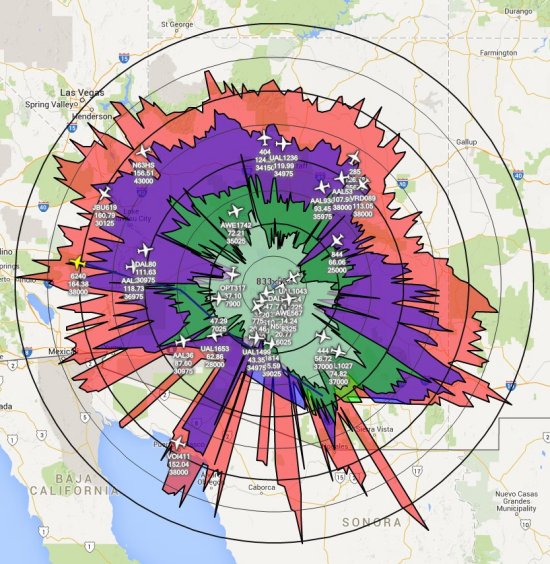
The above is a screenshot of the aggregated coverage over an approximate 120 hour period from last Saturday to now. The rings are spaced 50 km apart. As you can see, there are even a few a/c locations over 400 km away, which is incredible given that the house is in a bowl surrounded by hills or mountains in nearly all directions. For that one particular coverage radial SE into Sonora, that happens to be a very narrow clear shot (not including trees) from the house toward the horizon.
Initially, my setup included a simple discone antenna already sitting up on the roof, but in a day I had built the “QST Special” ADS-B antenna and my number of location messages went up from about 35k per day to over 130k per day.
After a few days of that, I raised the QST antenna by 4′ to get it above the parapet wall that surrounds the roof and the number of position reports went up by about 10-15% to about 150k. Next, I found in the garage a cheap (cheap being $5) cable satellite preamp and put that in line with the antenna. The position reports skyrocketed from about 150k to well over 200k per day. In fact, yesterday’s summary shows 240k+ position reports, and about 300 per second at peak times of the day. Here’s a chart which shows the changes in performance as a function of time and setup.

As can be seen, the performance continues to improve as the setup is further tweaked. Today (30 Jan) looks to be a bad day for reception. It has been raining lightly (about 0.03″/hr) since before midnight. I expect that at the current rate the station will receive only about 160k position reports today, which will be about 2/3 of yesterday’s performance.
My assumption right now is that the connected rain drops on the antenna radome are causing significant loss of signal at the antenna radome (the ABS pipe it’s covered with). It’s also possible that the added attenuation of the signals as they travel through the rain clouds and falling rain is a factor. Not sure which is more significant. At 1090 MHz, light rain shouldn’t be a really significant issue, but perhaps the PiAware software decoder is running right on the edge of performance so even a dB or so of added loss could have an impact.
While the rain is great, I look forward to a few weeks of dry skies so that I can get a solid number on the performance as a function of day of week.
